Buying insoles for arch support are usually done in order to relieve the pain from plantar fasciitis, neuroma, heel/arch pain, shin splints, knee and back pain and/or other ailments. Sometimes this purchase will lead to no relief of pain or possibly an increase in pain. Taking these 7 most common mistakes into consideration when buying your insoles will help insure you get the correct insoles. The proper insole will have a 3 point correction for the foot in the heel, arch and forefoot (ball of the foot).
- Not getting the correct insole for your foot type
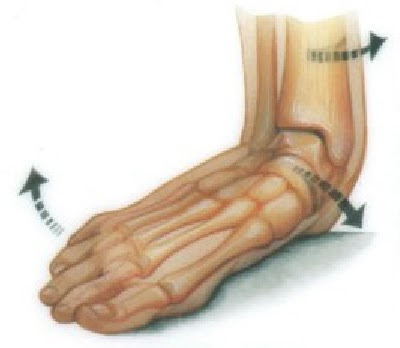 A person has either one of two foot types- flat or average. (I do see some people having one foot average and one foot flat though) Foot type is determined by the amount of pronation which is how much the arches fall and the ankles roll in. This can only be determined when standing on your feet. Many people think they don’t have much pronation since they only are looking at their feet when sitting.
A person has either one of two foot types- flat or average. (I do see some people having one foot average and one foot flat though) Foot type is determined by the amount of pronation which is how much the arches fall and the ankles roll in. This can only be determined when standing on your feet. Many people think they don’t have much pronation since they only are looking at their feet when sitting.
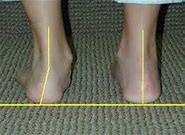 This is an example of a person with moderate to severe pronation or a flat foot since the ankle twists in and the arch collapses quite a bit.
This is an example of a person with moderate to severe pronation or a flat foot since the ankle twists in and the arch collapses quite a bit.
A person with flat feet needs a different correction than someone with an average arch. Just like people who are nearsighted are not able to get any relief if they buy glasses or contacts for someone farsighted. If I, as someone who has flat feet try to wear arch supports for average arches, it feels like a rolled up sock in the arch and is painful. Alternatively, people with an average or high arch wearing supports for flat feet will cause pain.
- Not getting the correct arch height
The arch height in an arch support needs to be high enough to provide support but also if someone has flat feet, the arch height may seem too high if the forefoot area is also not corrected.
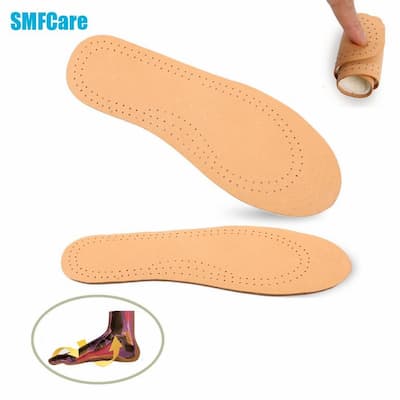 When someone has a flat foot, many OTC insoles will take the arch height and flatten the support thus it provides no support for the pronated foot. If you have flexible flat feet, this means you have an arch when sitting or laying down but the arch falls upon weight bearing. So the neutral position of the insole should be providing this person with support and not be flat.
When someone has a flat foot, many OTC insoles will take the arch height and flatten the support thus it provides no support for the pronated foot. If you have flexible flat feet, this means you have an arch when sitting or laying down but the arch falls upon weight bearing. So the neutral position of the insole should be providing this person with support and not be flat.
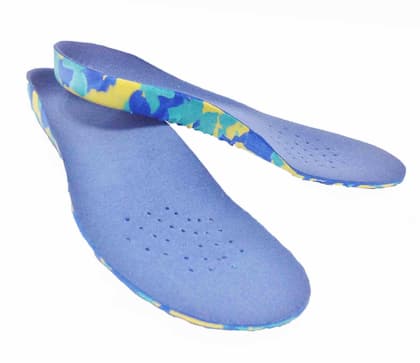 It is rare that the arch support is too high. However, if you have flat feet and you are buying insoles for a regular arch support that isn’t made for flat feet, it will feel like the arch height is too high. This is a sign you have flat feet! This high arch correction would feel like a rolled up sock and jam the arch. This flat foot if flexible still needs this level of arch support but the support also has to have correction in the ball of the foot.
It is rare that the arch support is too high. However, if you have flat feet and you are buying insoles for a regular arch support that isn’t made for flat feet, it will feel like the arch height is too high. This is a sign you have flat feet! This high arch correction would feel like a rolled up sock and jam the arch. This flat foot if flexible still needs this level of arch support but the support also has to have correction in the ball of the foot.
- Not getting the proper length of insole
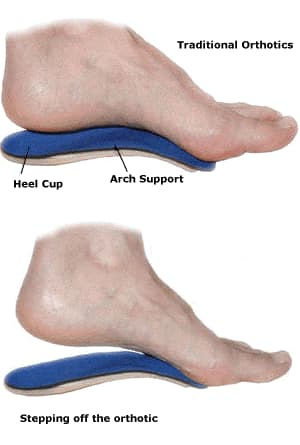 Most OTC (over the counter) insoles have the length of their arch support being too short. They often run from the heel to just behind the ball of the foot. This only provides 2 point correction – the heel and arch. The correct insole will provide 3 point correction in the heel, arch and ball of the foot (forefoot).
Most OTC (over the counter) insoles have the length of their arch support being too short. They often run from the heel to just behind the ball of the foot. This only provides 2 point correction – the heel and arch. The correct insole will provide 3 point correction in the heel, arch and ball of the foot (forefoot).
 When bridges are made, the support runs from end to end–heel to ball of foot and not end behind it. Doing so does not provide the most support for the arch. It also can cause some irritation to just behind the head of the ball of the foot.
When bridges are made, the support runs from end to end–heel to ball of foot and not end behind it. Doing so does not provide the most support for the arch. It also can cause some irritation to just behind the head of the ball of the foot.
- Not getting the right material that makes up the insole.
Insoles are made of varying materials. If too soft of material is used, the insole will not provide much support thus defeating the purpose of buying the insole in the first place.
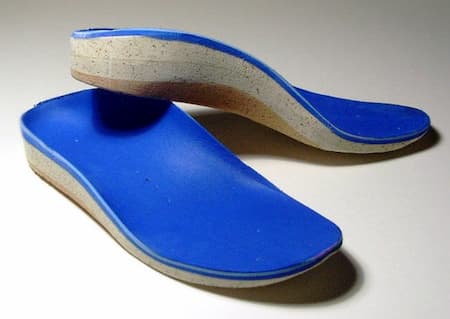 Having too hard of a material that doesn’t allow the arch to flex some usually is too rigid. This inability to allow some flexion is against the natural walk/run of someone that as the person steps down, the foot is flexing at the arch of the foot to allow for shock absorption. The best material to use is a semi-rigid material that provides the support but allows slight flexion.
Having too hard of a material that doesn’t allow the arch to flex some usually is too rigid. This inability to allow some flexion is against the natural walk/run of someone that as the person steps down, the foot is flexing at the arch of the foot to allow for shock absorption. The best material to use is a semi-rigid material that provides the support but allows slight flexion.
Some insoles also have a cushioning material on top of the actual support which is ideal to provide the cushion to the foot. But this cushioned material should not be the actual support because the foot will not actually get any support.
Additionally, if a softer material is used, some OTC insoles will have to be bulkier in order to provide support and thus take up too much room in the shoes.
- Not getting the right size
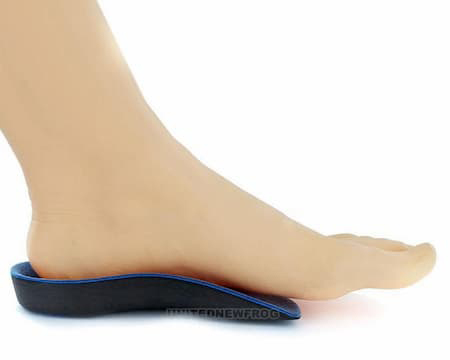 The insole has to be the right size and not a one size fits most or be fitted for 2-3 or more shoe sizes, i.e. fits sizes 6-9 womens shoe. Having the insole be too long or too short will not provide optimum support to the arch and may be uncomfortable.
The insole has to be the right size and not a one size fits most or be fitted for 2-3 or more shoe sizes, i.e. fits sizes 6-9 womens shoe. Having the insole be too long or too short will not provide optimum support to the arch and may be uncomfortable.
Often, people with flat feet will buy shoes that are too big because their foot flattens out and causes a spreading of the foot. By buying bigger shoes, this lessens the irritation of the flattened arch on the shoe. However, if one were buying insoles according to the shoe size that is too long, the insoles would not work as well.
- Not wearing shoes that are neutral or are worn down
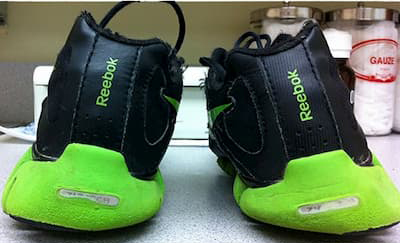 If the shoes are worn down or some shoes are literally made wrong, this will throw off the correction the insole is trying to provide and will make the insole ineffective. The best shoes will be lined up in the back and perpendicular to the floor. Many running shoes in the heel area will be built up on the inside or even have the inside material hard and the outside of the material soft thus throwing the heel outward.
If the shoes are worn down or some shoes are literally made wrong, this will throw off the correction the insole is trying to provide and will make the insole ineffective. The best shoes will be lined up in the back and perpendicular to the floor. Many running shoes in the heel area will be built up on the inside or even have the inside material hard and the outside of the material soft thus throwing the heel outward.
- Not giving the insole enough time to correct the foot
Since the foot and body are out of alignment and that is the reason you were buying insoles in the first place, sometimes the insoles will need a break in period. Many people will wear the insole for a couple hours or a day and think their problem will be fixed in a day but if they are having pain will stop wearing the insoles and give up. More than likely your foot, knee or hip problem has been going on for months or even years and the body needs time to let the muscles get stretched out in this new proper alignment. Making sure you follow the first 6 suggestions above will make sure you are starting out with the proper insole to begin with. If you purchased an insole and noticed one of the previous 6 mistakes when purchasing the insole no matter how much time you give the insole, the insole will not correct the problem.
What insoles are the best insole?
The best insoles for the feet are ones that are made for your foot type with a 3 point correction and are the correct height, length, material and size. J1 insoles come in two styles – the patented style for flat feet and the style for average or high arches. When buying insoles you need to have the 3 point correction in the heel, arch and forefoot along with having the arch support material made of medical grade plastic that provides semi-rigid support. J1 insoles are available in 8 adult and 8 child sizes- not one size fits all that require you to just trim them down to fit. J1 insoles are sold by shoe size (if the shoe size is appropriate for the foot as noted above).
J1 insoles are the best insoles for flat feet since we are the only insoles on the market for flat feet with our patented 3 point correction.
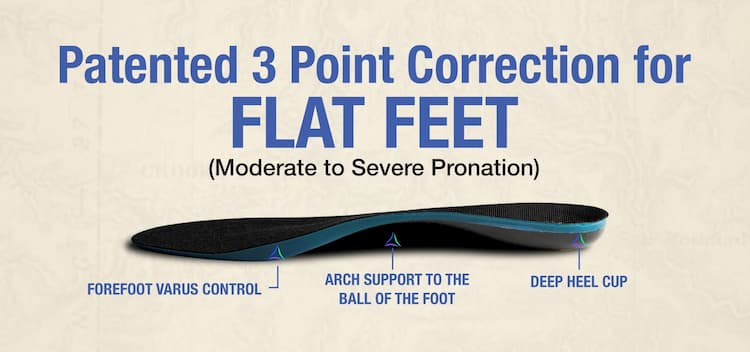
J1 insoles are the best insoles for higher arches. We have the 3 point correction with the deep heel cup, semi-rigid support material and the support goes to the ball of the foot.
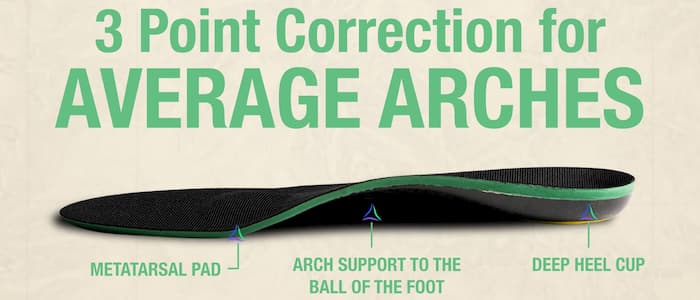
Getting the proper insole along with good supportive shoes will get you the pain relief you need and also help prevent other ailments that may come along.





